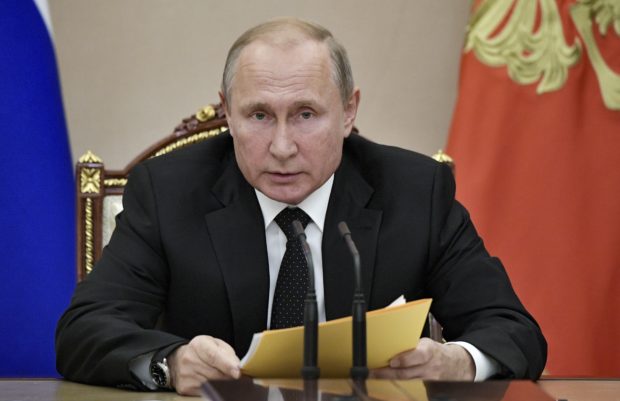Putin orders Russia to respond after US missile test

Russian President Vladimir Putin speaks at a meeting with members of the Security Council in the Kremlin in Moscow, Russia, Friday, Aug. 23, 2019. Putin ordered the Russian military to ponder a quid pro quo response after Sunday’s test of a new U.S. missile banned under a now-defunct arms treaty. (Alexei Nikolsky, Sputnik, Kremlin Pool Photo via AP)
MOSCOW — Russian President Vladimir Putin ordered the Russian military on Friday to work out a quid pro quo response after the test of a new U.S. missile banned under a now-defunct arms treaty.
In Sunday’s test, a modified ground-launched version of a Navy Tomahawk cruise missile accurately struck its target more than 500 kilometers (310 miles) away. The test came after the U.S. and Russia withdrew from the 1987 Intermediate-range Nuclear Forces (INF) Treaty.
The U.S. said it withdrew from the treaty due to Russian violations, a claim that Moscow has denied. Speaking Friday, Putin charged that the U.S. waged a “propaganda campaign” alleging Russian breaches of the pact to “untie its hands to deploy the previously banned missiles in different parts of the world.”
He ordered the Defense Ministry and other agencies to “take comprehensive measures to prepare a symmetrical answer.”
The Russian leader noted that Sunday’s test was performed from a launcher similar to those deployed at a U.S. missile defense site in Romania. He argued that the Romanian facility and a prospective similar site in Poland could also be loaded with missiles intended to hit ground targets instead of interceptors.
Article continues after this advertisementPutin has previously pledged that Russia would not deploy the missiles previously banned by the INF Treaty to any area before the U.S. does that first, but he noted Friday that the use of the universal launcher means that a covert deployment is possible.
Article continues after this advertisement“How would we know what they will deploy in Romania and Poland – missile defense systems or strike missile systems with a significant range?” Putin said.
Russia long has charged that the U.S. launchers loaded with missile defense interceptors could be used for firing surface-to-surface missiles. Putin said that Sunday’s test has proven that the U.S. denials have been false.
“It’s indisputable now,” the Russian leader said.
He added the missile test that came just 16 days after the INF treaty’s termination has shown that the U.S. long had started work on the new systems banned by the treaty.
Putin said Russia will continue working on new weapons in response to the U.S. moves but will keep a tight lid on spending.
“We will not be drawn into a costly arms race that would be disastrous for our economy,” Putin said, adding that Russia ranks the 7th in military spending after the U.S., China, Saudi Arabia, Britain, France, and Japan.
He added Russia remains open to an “equal and constructive dialogue with the U.S. to rebuild mutual trust and strengthen international security.” /kga